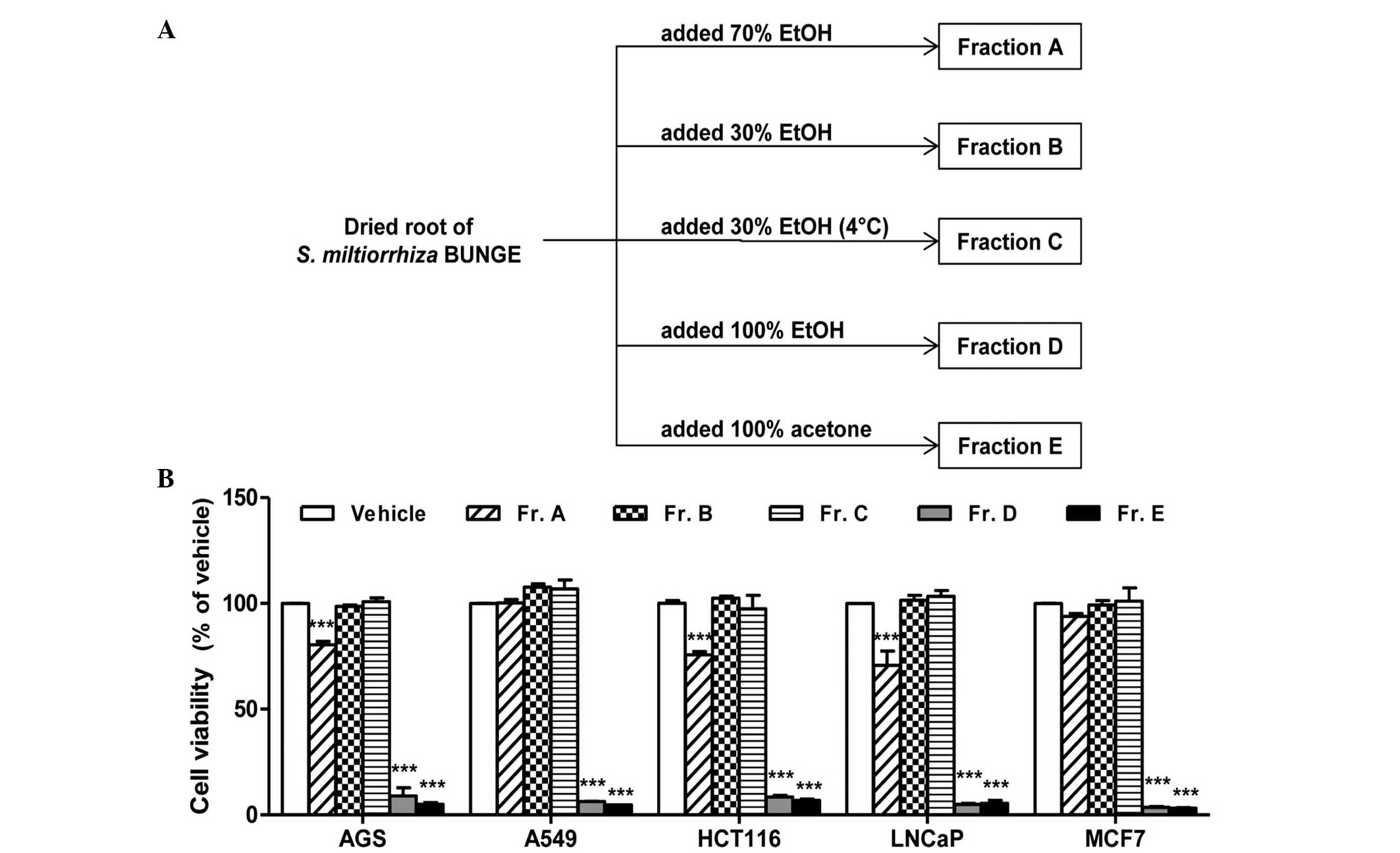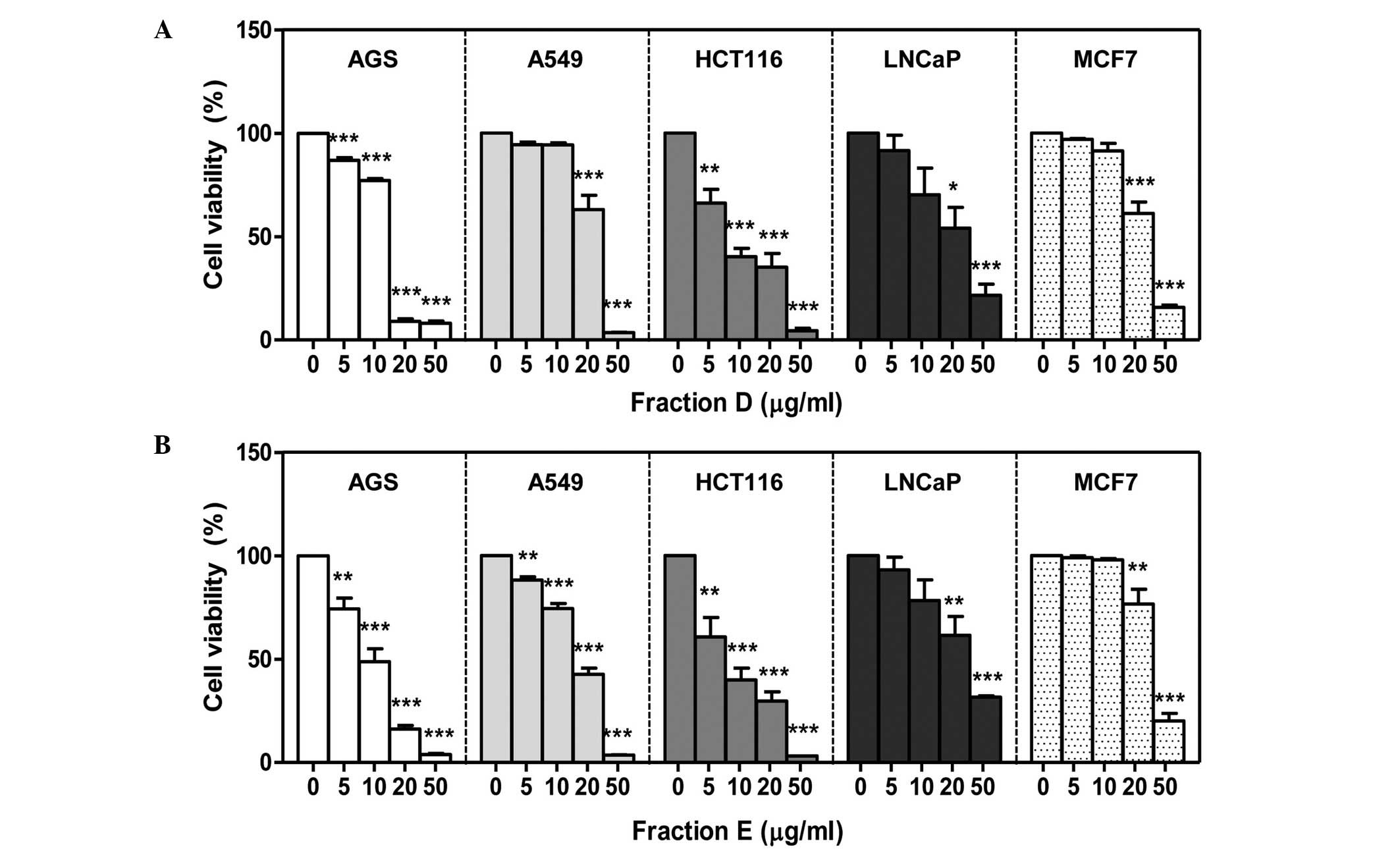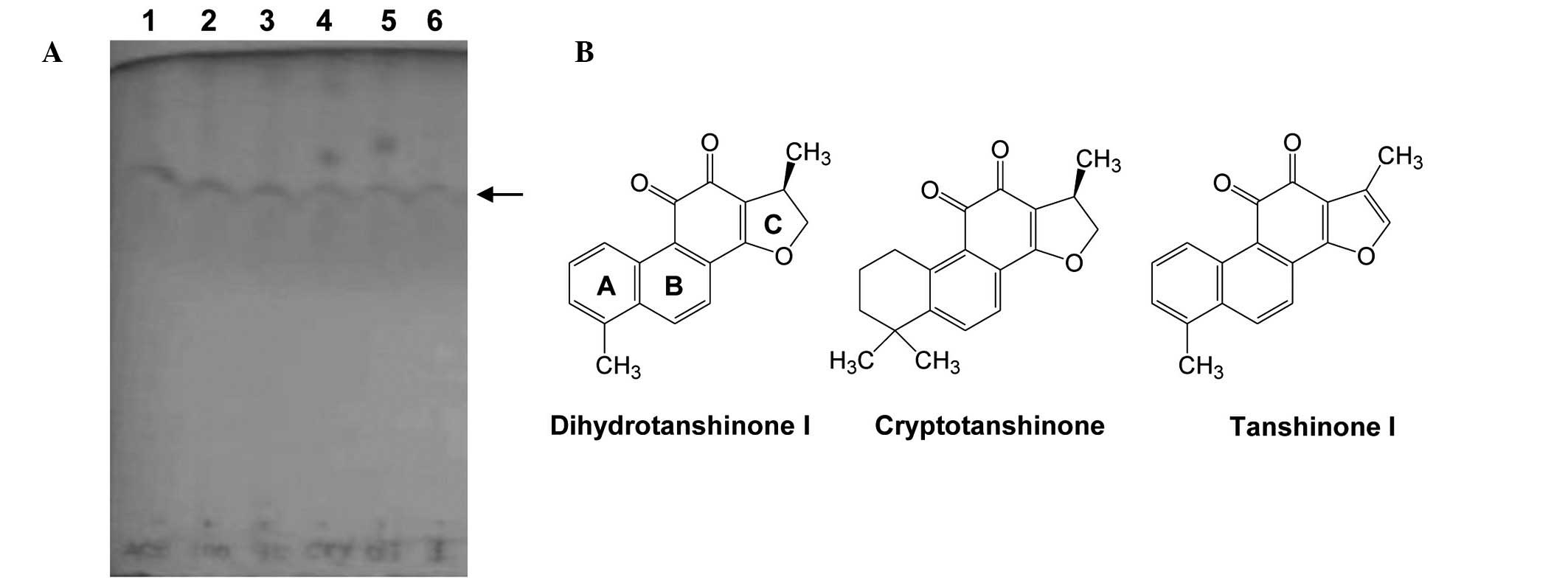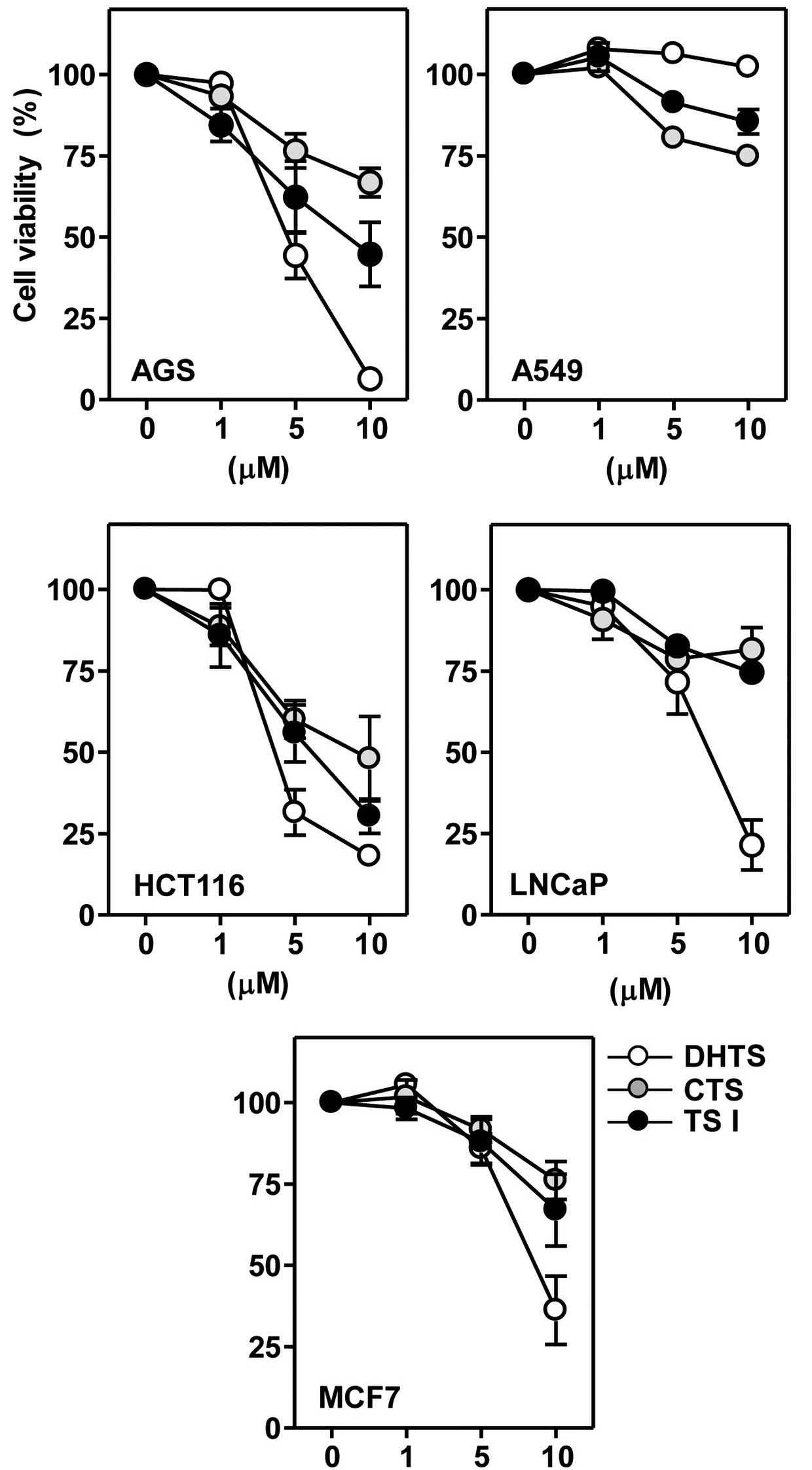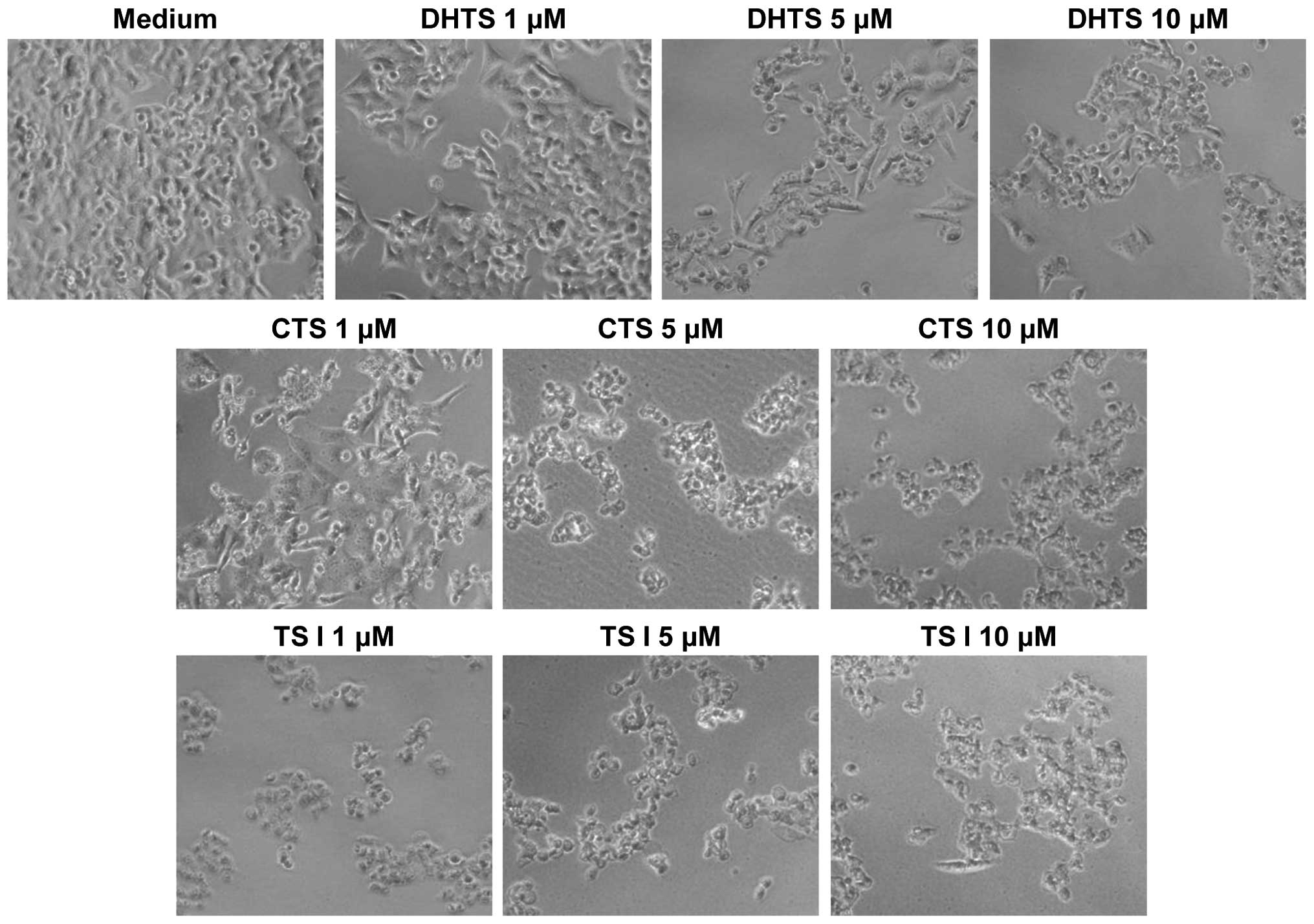|
1
|
Cheng TO: Cardiovascular effects of
Danshen. Int J Cardiol. 121:9–22. 2007. View Article : Google Scholar : PubMed/NCBI
|
|
2
|
Wasser S, Ho JM, Ang HK and Tan CE: Salvia
miltiorrhiza reduces experimentally-induced hepatic fibrosis in
rats. J Hepatol. 29:760–771. 1998. View Article : Google Scholar : PubMed/NCBI
|
|
3
|
Ahn YM, Kim SK, Lee SH, et al:
Renoprotective effect of Tanshinone IIA, an active component of
Salvia miltiorrhiza, on rats with chronic kidney disease. Phytother
Res. 24:1886–1892. 2010. View
Article : Google Scholar : PubMed/NCBI
|
|
4
|
Wen XD, Wang CZ, Yu C, et al: Salvia
miltiorrhiza (dan shen) significantly ameliorates colon
inflammation in dextran sulfate sodium induced colitis. Am J Chin
Med. 41:1097–1108. 2013. View Article : Google Scholar : PubMed/NCBI
|
|
5
|
Li YG, Song L, Liu M, Hu ZB and Wang ZT:
Advancement in analysis of Salviae miltiorrhizae Radix et Rhizoma
(Danshen). J Chromatogr A. 1216:1941–1953. 2009. View Article : Google Scholar : PubMed/NCBI
|
|
6
|
Tao S, Zheng Y, Lau A, et al: Tanshinone I
activates the Nrf2-dependent antioxidant response and protects
against As(III)-induced lung inflammation in vitro and in vivo.
Antioxid Redox Signal. 19:1647–1661. 2013. View Article : Google Scholar : PubMed/NCBI
|
|
7
|
Park EJ, Zhao YZ, Kim YC and Sohn DH:
Preventive effects of a purified extract isolated from Salvia
miltiorrhiza enriched with tanshinone I, tanshinone IIA and
cryptotanshinone on hepatocyte injury in vitro and in vivo. Food
Chem Toxicol. 47:2742–2748. 2009. View Article : Google Scholar : PubMed/NCBI
|
|
8
|
Tao S, Justiniano R, Zhang DD and Wondrak
GT: The Nrf2-inducers tanshinone I and dihydrotanshinone protect
human skin cells and reconstructed human skin against solar
simulated UV. Redox Biol. 1:532–541. 2013. View Article : Google Scholar : PubMed/NCBI
|
|
9
|
Mahesh R, Jung HW, Kim GW, Kim YS and Park
YK: Cryptotanshinone from Salviae miltiorrhizae radix inhibits
sodium-nitroprusside-induced apoptosis in neuro-2a cells. Phytother
Res. 26:1211–1219. 2012. View
Article : Google Scholar : PubMed/NCBI
|
|
10
|
Jeon SJ, Son KH, Kim YS, Choi YH and Kim
HP: Inhibition of prostaglandin and nitric oxide production in
lipopolysaccharide-treated RAW 264.7 cells by tanshinones from the
roots of Salvia miltiorrhiza bunge. Arch Pharm Res. 31:758–763.
2008. View Article : Google Scholar : PubMed/NCBI
|
|
11
|
Trinh HT, Chae SJ, Joh EH, Son KH, Jeon SJ
and Kim DH: Tanshinones isolated from the rhizome of Salvia
miltiorrhiza inhibit passive cutaneous anaphylaxis reaction in
mice. J Ethnopharmacol. 132:344–348. 2010. View Article : Google Scholar : PubMed/NCBI
|
|
12
|
Wang X, Morris-Natschke SL and Lee KH: New
developments in the chemistry and biology of the bioactive
constituents of Tanshen. Med Res Rev. 27:133–148. 2007. View Article : Google Scholar
|
|
13
|
Zhang Y, Jiang P, Ye M, Kim SH, Jiang C
and Lu J: Tanshinones: sources, pharmacokinetics and anti-cancer
activities. Int J Mol Sci. 13:13621–13666. 2012. View Article : Google Scholar : PubMed/NCBI
|
|
14
|
Lee WY, Chiu LC and Yeung JH: Cytotoxicity
of major tanshinones isolated from Danshen (Salvia miltiorrhiza) on
HepG2 cells in relation to glutathione perturbation. Food Chem
Toxicol. 46:328–338. 2008. View Article : Google Scholar
|
|
15
|
Lee JH, Shin YJ, Kim HJ, Oh JH, Jang YP
and Lee YJ: Danshen extract does not alter pharmacokinetics of
docetaxel and clopidogrel, reflecting its negligible potential in
P-glycoprotein- and cytochrome P4503A-mediated herb-drug
interactions. Int J Pharm. 410:68–74. 2011. View Article : Google Scholar : PubMed/NCBI
|
|
16
|
Zhao Y, Hao Y, Ji H, et al: Combination
effects of salvianolic acid B with low-dose celecoxib on inhibition
of head and neck squamous cell carcinoma growth in vitro and in
vivo. Cancer Prev Res (Phila). 3:787–796. 2010. View Article : Google Scholar
|
|
17
|
Franek KJ, Zhou Z, Zhang WD and Chen WY:
In vitro studies of baicalin alone or in combination with Salvia
miltiorrhiza extract as a potential anti-cancer agent. Int J Oncol.
26:217–224. 2005.
|
|
18
|
Wang SX, Hunter W and Plant A: Isolation
and purification of functional total RNA from woody branches and
needles of Sitka and white spruce. Biotechniques. 28:292–296.
2000.PubMed/NCBI
|
|
19
|
Qiu F, Jiang J, Ma Y, et al: Opposite
effects of single-dose and multidose administration of the ethanol
extract of Danshen on CYP3A in healthy volunteers. Evid Based
Complement Alternat Med. 2013:7307342013. View Article : Google Scholar : PubMed/NCBI
|
|
20
|
Plaza M, Santoyo S, Jaime L, et al:
Screening for bioactive compounds from algae. J Pharm Biomed Anal.
51:450–455. 2010. View Article : Google Scholar
|
|
21
|
Starmans DAJ and Nijhuis HH: Extraction of
secondary metabolites from plant material: A review. Trends Food
Sci Techol. 7:191–197. 1996. View Article : Google Scholar
|
|
22
|
Li BB, Smith B and Hossain MM: Extraction
of phenolics from citrus peels I. Solvent extraction method. Sep
Purif Technol. 48:182–188. 2006. View Article : Google Scholar
|
|
23
|
United States Food and Drug
Administration. Generally Recognized as Safe (GRAS). http://www.fda.gov/Food/IngredientsPackagingLabeling/GRAS/uri.
Accessed October 5, 2014
|
|
24
|
Korean Food and Drug Administration.
Regulation on approval of functional food ingredients for health
functional food. http://www.foodnara.go.kr/hfoodi/industry/main/sub.jsp?Mode=view&boardID=s_0502_bbs&num=96&tpage=3&keyfield=&key=&bCate=uri.
Accessed October 5, 2014
|
|
25
|
Chang JY, Chang CY, Kuo CC, Chen LT, Wein
YS and Kuo YH: Salvinal, a novel microtubule inhibitor isolated
from Salvia miltiorrhizae Bunge (Danshen), with antimitotic
activity in multidrug-sensitive and -resistant human tumor cells.
Mol Pharmacol. 65:77–84. 2004. View Article : Google Scholar : PubMed/NCBI
|
|
26
|
Bi L, Chen J, Yuan X, Jiang Z and Chen W:
Salvianolic acid A positively regulates PTEN protein level and
inhibits growth of A549 lung cancer cells. Biomed Rep. 1:213–217.
2013.
|
|
27
|
Yang Y, Ge PJ, Jiang L, Li FL and Zhu QY:
Modulation of growth and angiogenic potential of oral squamous
carcinoma cells in vitro using salvianolic acid B. BMC Complement
Altern Med. 11:542011. View Article : Google Scholar : PubMed/NCBI
|
|
28
|
Jeong JB and Lee SH: Protocatechualdehyde
possesses anti-cancer activity through downregulating cyclin D1 and
HDAC2 in human colorectal cancer cells. Biochem Biophys Res Commun.
430:381–386. 2013. View Article : Google Scholar
|
|
29
|
Li H, Zhang Q, Chu T, et al:
Growth-inhibitory and apoptosis-inducing effects of tanshinones on
hematological malignancy cells and their structure-activity
relationship. Anticancer Drugs. 23:846–855. 2012. View Article : Google Scholar : PubMed/NCBI
|
|
30
|
Lee WY, Cheung CC, Liu KW, Fung KP, Wong
J, Lai PB and Yeung JH: Cytotoxic effects of tanshinones from
Salvia miltiorrhiza on doxorubicin-resistant human liver cancer
cells. J Nat Prod. 73:854–859. 2010. View Article : Google Scholar : PubMed/NCBI
|
|
31
|
Wu W, Zhu Y, Zhang L, Yang R and Zhou Y:
Extraction, preliminary structural characterization, and
antioxidant activities of polysaccharides from Salvia miltiorrhiza
Bunge. Carbohydr Polym. 87:1348–1353. 2012. View Article : Google Scholar
|
|
32
|
Zhou L, Zuo Z and Chow MS: Danshen: an
overview of its chemistry, pharmacology, pharmacokinetics, and
clinical use. J Clin Pharmacol. 45:1345–1359. 2005. View Article : Google Scholar : PubMed/NCBI
|
|
33
|
Wu WL, Chang WL and Chen CF: Cytotoxic
activities of tanshinones against human carcinoma cell lines. Am J
Chin Med. 19:207–216. 1991. View Article : Google Scholar : PubMed/NCBI
|
|
34
|
Gong Y, Li Y, Lu Y, et al: Bioactive
tanshinones in Salvia miltiorrhiza inhibit the growth of prostate
cancer cells in vitro and in mice. Int J Cancer. 129:1042–1052.
2011. View Article : Google Scholar :
|
|
35
|
Liu L, Jia J, Zeng G, et al: Studies on
immunoregulatory and anti-tumor activities of a polysaccharide from
Salvia miltiorrhiza Bunge. Carbohydr Polym. 92:479–483. 2013.
View Article : Google Scholar
|
|
36
|
Bao YX, Wong CK, Leung SF, et al: Clinical
studies of immunomodulatory activities of Yunzhi-Danshen in
patients with nasopharyngeal carcinoma. J Altern Complement Med.
12:771–776. 2006. View Article : Google Scholar : PubMed/NCBI
|
|
37
|
Wong CK, Bao YX, Wong EL, Leung PC, Fung
KP and Lam CW: Immunomodulatory activities of Yunzhi and Danshen in
post-treatment breast cancer patients. Am J Chin Med. 33:381–395.
2005. View Article : Google Scholar : PubMed/NCBI
|



